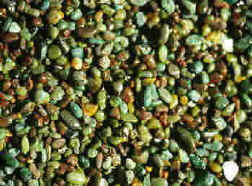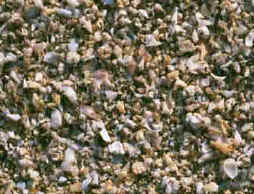|
Geologists identify sedimentary rocks based on their texture
(appearance) and their mineral composition. The texture of clastic
sedimentary rocks can describe the grains of sand in the rock. In this
lab, you will consider three textures. First, we will look at the size
of the sediment particles. For example, "sand-sized" means
particles from 1/16 to 2 mm in diameter. The grain size of sediments
usually decreases as a stream transports grains downhill to the ocean or
large lake.
The second feature is roundness, defined as the presence or
absence of corners and sharp edges on the particles. Particles with many
edges are "angular". Particles lacking edges are
"rounded". Particles get rounder as they are transported;
their corners get broken off as they bump against other particles and
the streambed.
Finally, the sorting of particles is a texture that indicates
how long the sediments have been in the water system. Poorly sorted
sediments show a wide range of grain sizes, while well-sorted ones have
similar sized grains. Like rounding, sorting increases with
transportation.
|

Rodeo Beach, California

Massawa, Eritrea, Africa
|